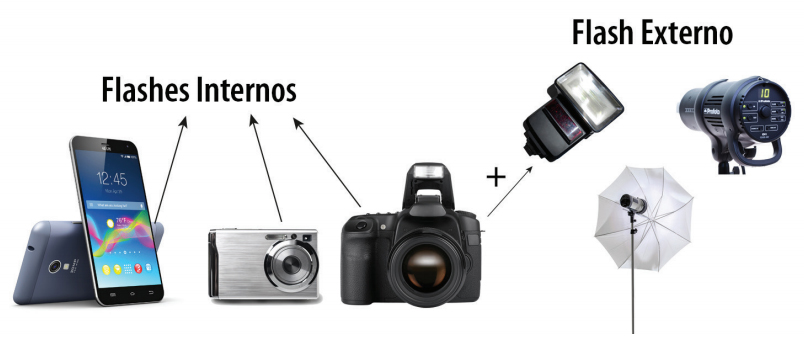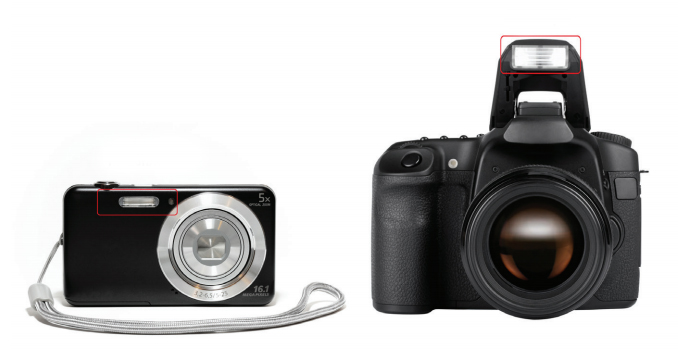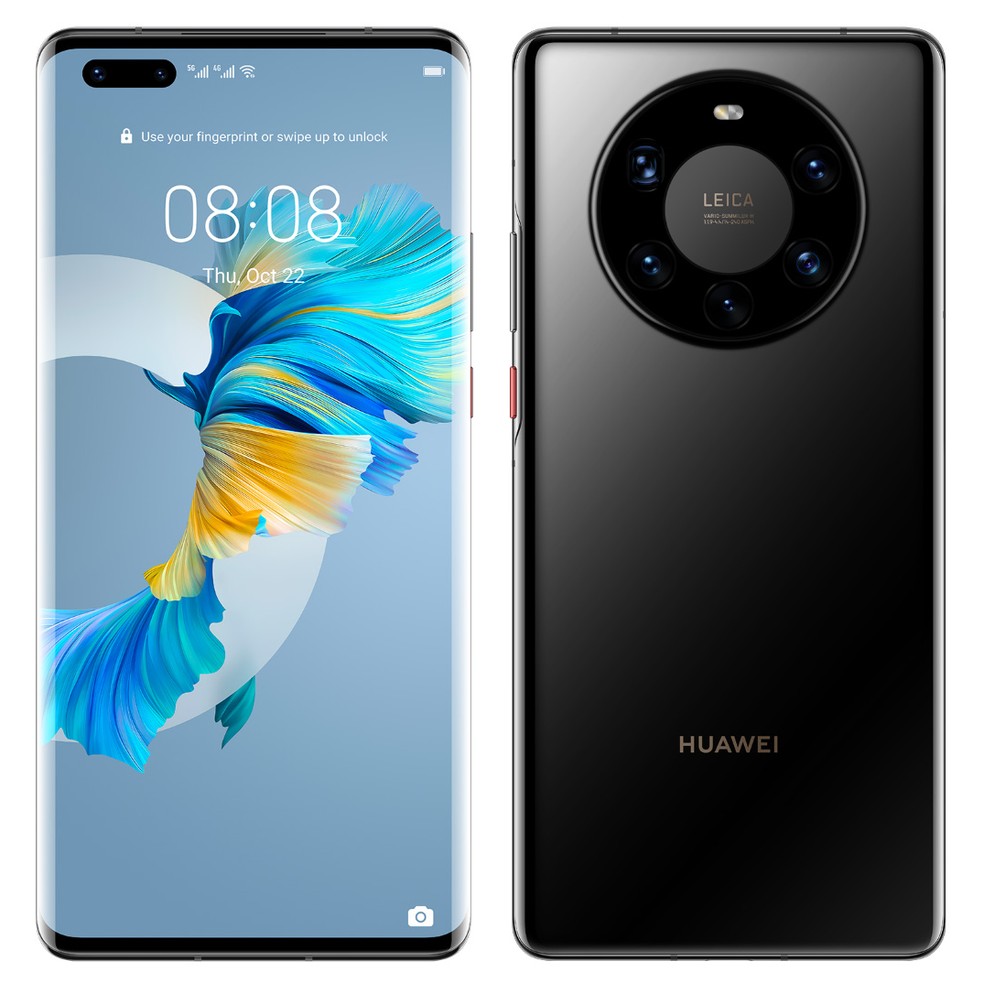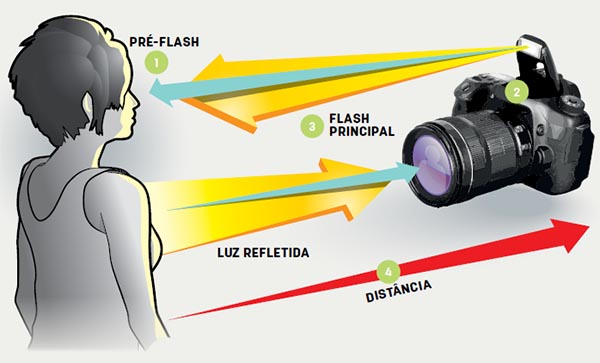Types of Flash
At first there are two types of auxiliary lighting: internal flash (built-in or pop-up) and external flash. The first type is inside the camera and shoots a beam of light in the same direction as the lens. The external flash is a separate equipment, to be attached to the top of the camera, or used on a tripod. While the built-in flash has its light power of shorter range, the external flash is able to reach the farthest distance to be lit.
The main differences between the two styles of flash are in the range of light fired and also in the direction it travels towards the subject. While built-in flashes are practical and don't add extra weight to the equipment, they have limitations.

Integrated Flash (built-in, pop-up) | Types of Flash
Smartphones and simpler or compact models of still cameras have a type of flash known as built-in. It emits a directed point of light, triggered when compensating for ambient lighting. For each manufacturer and type of equipment, the flash must respond in unique ways. However, it is important to note that the light emitted by these types is limited in terms of distance and results.
A short-distance beam of light is projected directly onto the subject. Therefore, in general, the photos taken by this type of flash have high brightness and chromatic imbalance, especially in subjects in light colors and in the foreground. Unlike external flashes, bouncing the light or changing its direction turns out to be an extremely difficult task, causing a less subtle effect in the photos.
Limitations
The built-in flashes do not allow you to change the direction of the light, bounce it off or change its angle. The main negative effect is the loss of shadows and volumes of the subject, generation of a hard shadow and generation of unwanted glare.
These types of flash are integrated in cell phones and compact cameras, and in DSLR and other mid-range camera models.

Cell phone companies are constantly working to improve their equipment. One of these improvements corresponds to the introduction of a bigger and better combination between the volume and the positioning of the LED lamps, in both the front camera and the rear camera.
Due to the accelerated growth and the role of social networks in the economy, companies are constantly developing new devices to be coupled to smartphones.

External flash (Dedicated) | Types of Flash
Flash models that can be attached to the camera or commanded outside of it are called external, that is, they have operational autonomy even when detached from the camera body.
There are many and varied types of lighting equipment used both in photo studios and outside. However, in this article, I will retain the understanding of dedicated type external flash. Leading manufacturers in the market use the name speedlite (Canon) or speedlight (Nikon). I will cover other flash models in a more in-depth article on the subject.
Although lighting control is more creative and predictable from an auxiliary lighting set, such as in a studio, the main difference between this type of lighting and dedicated flash is in the portability offered by these small and light features. Imagine recording an event where you and the people involved are in constant motion, it would be very difficult to record all the important situations instantly if you had to carry one or more tripods with you.
The dedicated flash is also operated outside the camera, through a remote trigger that establishes the connection between the equipment and can also communicate with other secondary flashes called slaves, or slaves, activated after the signal from the master or main flash.
How to Use Flash?
Many professionals and photography lovers fear the flash and prefer not to use it due to the very impactful lighting produced by these devices on subjects at close range. This is because the charge of light emitted by the flash is directly linked to the range of this light in relation to the subject to be photographed. While external flashes reach about ten meters away with good coverage, DSLRs' pop up flashes are limited to distances of up to four meters.
Thus, the light load emitted by your flash (often confused with power) has much more to do with the environment and the distance between subjects than with the “strength” of that light itself. For example, if you want to work photographing subjects close to the camera, a flash with a high indicative of guide number - I'll cover later. Therefore, when working with flash, you will need to pay attention not only to the load measurement offered by the equipment, but also in relation to the distance and direction of the light.
To introduce the use of internal or external flash in your photos initially with quality, it is essential that you know some features offered by the equipment itself.
red eye reduction
The flash light is fired in fractions of a second, very quickly, until it reaches our pupil. This causes
the blood vessels within the eyeball are illuminated and revealed in the image. With the red-eye reduction option turned on, the flash makes small pulses of light before the final shot, so that our pupils become
contract, allowing less light to reach the eyes after the main shot. Even if the problem is not completely eliminated, it will be greatly minimized.
slow sync flash
This feature activates a very slow shutter-curtain opening and closing speed, which requires a lot of firmness when shooting, preferably using a stand or a tripod. The feature will provide a longer exposure time and flash duration to capture any and all types of lighting in the environment, highlighting
thus the entire composition, rather than punctual subjects.
TTL (Through The Lens – through the lens) measurement mode
It is an automatic way to calculate flash power offered by some camera models and dedicated flashes. The camera's photometer reads the exposure and works in sync with the internal or external flash.
This mode takes into account the flash's distance from the main subject and measures the ideal fired charge through the crossing of information that you can adjust from the exposure triangle, considering
aperture, shutter speed, ISO, auto focus, and photometry from the surfaces involved in the scene. All of this data is returned to the camera within fractions of a second, before the final shot.

HSS (High Speed Sync) mode
Mode used in situations where you want to isolate the main subject from the background, reducing ambient light as much as possible. This mode, available for some external flash models, allows the camera shutter to work at high speed without the risk of recording the opening and closing movement of the shutter curtain, so for use without this feature, it is 1/250 second shutter speed limit recommended; otherwise, your photos may contain a dark band resulting from capturing part of the opening curtain and closing the shutter.
For a correct exposure, the distance of the flash in relation to the main subject and also the range of the luminous force emitted by it are some of the main factors to be observed.
While external flash charge distribution can be performed by TTL mode or manual mode, on newer camera models, pop up flash power is performed only by TTL mode and its correction can be performed via the exposure triangle or flash exposure compensation.
Since the flash load is automatically calculated, the compensation for underexposed or overexposed photos is adjusted in-camera.
Using Flash in TTL Mode Through the Exposure Triangle
The flash works in conjunction with the sensor's absorption of light. The role of the shutter is to allow light to enter through its curtains, reaching the sensor in order to capture more or less light in the environment (read: the slower the shutter speed, the longer the exposure time and, therefore, greater ambient light capture). However, the shutter has no direct influence on the result of flash light on the main subject, which will be illuminated after shooting. The shutter speed will have an influence on the environment, not the main subject.
Thus, flash luminous strength control is not measured by shutter speed, but by aperture and ISO sensitivity. The larger the aperture, the greater the incidence of light and, therefore, the lower the luminous force needed to fire the flash. In this condition, the more closed the diaphragm, the less light enters and, therefore, the darker the resulting photos. Regarding the ISO, the lower the ISO number, the lower the risk of graininess, however, the darker the photos produced.
The TTL mode is the one that crosses this measurement data to determine the required light load on the subject. Therefore, when shooting in this mode, you adjust your equipment to your preferred settings between ISO and aperture and, after testing, verify the need to change one of these two pillars, in addition to the possibility of compensating for the exposure of the flash for more or less exposed (brighter or darker) photos.
CONTINUED IN NEXT ARTICLE
Anyway, we will meet in the next article on photographic technique.
So, did you like the article and want to contribute a coffee of thanks? Make your contribution through the QR Code below. Help the Foto Blog that helps you. Any value is welcome! A coffee is R$2 here, for example.

Related articles
| | Make long exposure | | Types of cameras | | Light the principle (part 1) | | Light the principle (part 2) | |
Other links
| | Photo Accessories | | Types of Flash | | Photography | | Online Gallery | | FotoBlog | | Photometry | | Photographic Technique || Color Photographic Technique | | Quality of a photo | | What is Photography? | | The Role of the Sensor | | Pricing | | Diaphragm Exposure Triangle | | Lens Types | |





